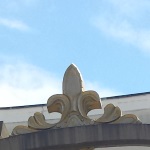Fleur-de-lis Cross

The Fleur-de-lis Cross is a cross adorned with lily petals at the arm-ends, and is very similar to the Fleurie Cross and the Patonce Cross with liliform ends.
Not only do the arm-ends represent flowers, but they also have the appearance of a barbed fighting spear. Therefore these crosses are used mainly in heraldry, especially in France.
Although lis is French for lily, the Fleur-de-lis Cross should not be confused with the Lily Cross, which is a cross emblazoned with one or more white trumpet-shaped arum lilies, used for Easter or funeral decoration.

Madonna Lily
The lily in Christian art is a well-known symbol of chastity, innocence and purity. It began appearing in religious art of Annunciation scenes in the late 14th century. (The Archangel Gabriel and Mary are sometimes shown holding a Lily.) The pure, immaculate white petals give an alternative name, the Madonna Lily. In addition to the lily, Mary is also associated with the rose "I am the Rose of Sharon, a lily of the valleys".
After the Protestant Reformation, in an attempt to focus more on Jesus and less on His Mother, the lily and the Rose of Sharon became popular symbols for Christ. An example is seen in the logo of the Evangelical Lutheran Church of Latvia (Latvijas evaņģēliski luteriskā baznīca: LEBL).
The fleur-de-lis symbol is a stylized lily and has been a symbol of French royalty since the 11th century. Indeed, the English King Edward III incorporated the symbol on his coat of arms to emphasize his claim to the French crown. The symbol became less prominent in France after the French Revolution and was dropped by the English monarchy in 1801. It retained its image as a regal symbol, however, becoming popular in heraldry.
Another name is Gaelic Cross, although that title is more commonly used to describe the Celtic Cross.
More recently, the Fleur-de-lis Cross has been adopted by the life-is-dark, neo-Goth subculture. It is known as the Gothic Cross or Renaissance Cross and often worn satirically, accompanying grim black attire (see also Dracula Cross).
Both 'Lily' and 'Fleur-de-lis' sound a bit too antiquated for 'New-Age' followers, who call it the Lotus Cross. And it's easy to see why.
The photo on the right may appear to Western eyes as a Fleur-de-lis but in fact is symbolic of a lotus flower, crowning the entrance of Kohodo Temple – a quiet and simple Buddhist temple, not intended to impress anyone with its architecture, and just a few hundred metres from the famous tourist-packed Zojo-ji Temple in Minato, Tokyo
In both the Fleur-de-lis Cross and the Fleurie Cross, the three petals represent faith, wisdom and chivalry when used in heraldry, and the Trinity when used as a Christian Cross.
See also:
Song. 2:1
See also the Rose of Sharon Cross and also the Avis Cross. Avis is another female name that is associated with a Latin word meaning 'bird'.
One of the most popular stories of the French Revolution; Les Misérables








